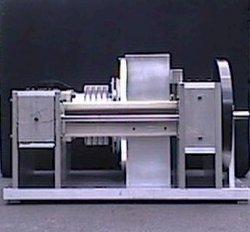
Entropy engine prototype
Again and again, inventors try to surpass the barriers of physics and achieve the ultimate breakthrough in construction of a perpetual motion machine. Here I show some actual concepts, which at a close glance show typical elements of classical PMMs. Also the claim to generate energy has not changed. As meanwhile inventors have learned that talking about perpetual motion engines causes remembrance of old prejudices, now they agree that these devices are impossible. It is more elegant and convincing to talk about open systems, ether theories and free energy. In this way, a serious discussion can take place.
I'd like to point out explicitly, that the authors and inventors referred here, unlike typical frauds, do not make any secrecy around their ideas and practical experiments. Whoever invests a little effort in getting their documents from the web can make up his own conclusions.
As examples, I briefly present some modern concepts, which partially became known by prototypes or experimental machines:
Sanjay Amin, a young inventor rouse a sensation in 1999, as he presented a new type of themodynamic circular process and an experimentatal prototype to the public. In a nutshell, Amin claimed to have barred a Maxmellian demon into a handy aggregate. Amin gave numerous self-concious interviews, in which he declared his success a a "revolution in physics". Needless to say that he had the mass medias' attention and that of his alma mater, the Youngston State University, Ohio. Subsequently, Amin founded the "Entropy Systems" company and collected 3,4 million.$ from sponsors in order to get his principle embedded into a machine suitable for series production.
The internet site of Entropy Systems reported about technology and business model, and about the fact that only a small step had to be done to develop a commercial product based on the principle. Everthing looked pretty favorable for Amin.

Entropy engine prototype
Some reputable physicists working in the field of thermodynamics had objections. Questions were not only asked by internet news magazines like the german Net Magazine Telepolis, but also in scientific and free energy discussion groups.
The German physicist Prof. Bruhn made a detailled theoretical analysis entitled Sanjay Amin's Entropy Engine - deflated? His result simply was that the second law of thermodynamics was not endangered by the principle. I don't know, how Sanjay Amin's career continued, but the site www.entropysystems.com is again on disposition since more than one year.
A very interesting mechanical machine which uses gravitational and centrifugal forces to generate more energy than fed into the mechanism. Würth's older internet site stated that first experimental samples showed overunity behaviour with an efficiency of around 135%. Würth's own estimates went up to 700% or 800% for well-developed mechanisms of this kind.
All his mechanisms have a common construction feature which already can be found in Bhaskara's wheel. Attached to a wheel are excentic seemingly unbalanced masses, which can rotate around their own axles. As there is a mechanism either by chains or by cog wheels, the center of gravity remains identical with the main axis of the system, whereas the angular speed may change due to reasons of angular momentum. There is a very remarkable difference between classical arabian wheels and the mechanism discussed here, as there are setups which show a vertical axis, thus implying that the machine is expected to work independently from gravitational force.
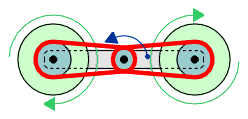
Kinematic layout of Würth's wheel
Würth explicitly states on his internet site, that he knows about the
impossibility of perpetual motion machines and that the law of energy
conservation holds for closed systems. To make it clear, for closed systems
only, but his device is an open system. Indeed, we have to ask: What
is meant by open? Is Würth's machine some sort of an equivalent
to a heat pump, that apparently "produces" more energy than needed to keep
it running?
For simplicity, I name this mechanism Würth Converter abbreviated
WW (for German Würth-Wandler). Let's assume, the WW works in
the intended way, then I can imagine a future vehicle's engine based on it.
A schematic shall illustrate how the engine might work:
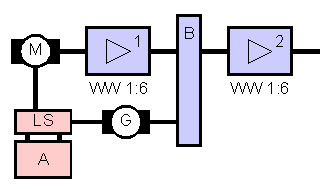
| M | electric motor ca. 1kW |
| WW 1 | Würth converter 1:6 = 600% efficiency |
| B | Gearbox |
| G | Generator ca. 1kW |
| LS | Charge and control electronics |
| A | Accumulator |
| WW 2 | Würth-converter 1:6 = 600% efficiency |
I have assumed an efficiency of 600% for the WW, which seems an appropriate
assumption if we keep Würth's own estimate in mind. The function of
this aggregate is easily explained.
The buffer accumulator and the charge/control electronics are needed to power
the motor M, in order to get the whole machine started. The maximum power
of 1kW is fed into WW1 and there amplified by 6. The mechanical output powers
the gearbox which has two output shafts. One is used to power the generator
G, thus charging the battery and powering the motor M. The second shaft feds
the second WW2, thus being the "power booster" of the machine.
The next diagram illustrates the electrical and mechanical energy flow. In all components, except the Würth converters, I have assumed conventional efficiency.

| Direction | Type of power | Power |
|---|---|---|
| LS ® M | electric | 1100W |
| M ® WW1 | mechanic | 1000W |
| WW1 ® B | mechanic | 6000W |
| B ® G | mechanic | 1400W |
| G ® V | electric | 1300W |
| LS ® A | electric | 1200W |
| B ® WW2 | mechanic | 4400W |
| WW2 ® output | mechanic | 26,4kW |
Don't be confused by the circular path of approximately 1.3kW inside the electric part of the system. I haven conciously chosen a relatively bad efficiency for this part. This portion of the machine is no PMM, but a type of technology sometimes used in electrohydraulic machinery to adjust speed by planet gears. As the efficiency factor of the Würth converters is assumed as constant, the mechanical output power easily can be controlled by the input power into the electric motor.
The only unconventional power flow are the two paths indicated by green arrows. The WWs must "know" how to tap energy from "outside", to keep the system running. To explicitly state it again: under the precondition that this system is really open, it would work. But again: What is "open"? And where lacks the "free energy" tapped from somewhere?
I've nearly decided to buy a Würth converter, when I stumbled into this
article by W.D.Bauer:
The Wuerth
overunity rotator claim. In the past, Bauer had already delivered a
mathematical theory why and how a Würth converter works (unfortunately
it seems that his calculations contained some minor, but important flaws).
The revised article gets to a very interesting conclusion: "The calculation
predicts no overunity behaviour for any cycle path because the mathematical
description fulfills Hamiltonian energy conservation" (p.1, abstract).
So my new, ecological car engine remains a dream for some more time, as I
decided not to buy a Würth converter in the near future.
The Evert-Rotor is one of the theories and inventions that shall have or attention now. Prof. Evert has found by an esoteric variant of classical brainstorming techniques ("remote viewing") how the Bessler wheel had worked. His results were published in different places and also can be read on Prof. Evert's internet site. I'm not going to discuss the method which served to explore the secret, but surprising enough, the power source for the wheel seems not to be a maid-servant.
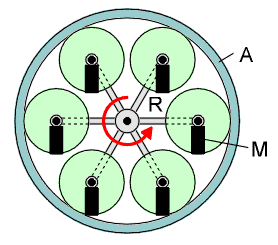
A mechanical schematic of the Bessler
rotor reconstructed by Prof. Evert
| R | common rotor |
| M | excentric masses at the outer rim |
| A | outer cog rim, can rotate or remain static |
There are many similarities between this design and Würth's ideas, which can be explained by the communication between the two inventors. The mechanical principles are almost the same, which causes me hesitating to build an experimental device of this type. At least one major difference can be seen between the two concepts: the location of the rotating masses' commen center of gravity. In Würth's scheme, it is stays identical with the main axis, whereas in Evert's scheme, it is excentric from the common axis and rotates around it with an angular speed depending from the cogs' ratios.
Besides the Bessler wheel reconstruction many other concepts can be found, of which I wlll briefly discuss these two:
To avoid misunderstandings, I think these names are not the best choice.
Evert describes a simple machine which was built by a farmer in the US. The device consists of a electric motor, a V-belt, an old motorbike wheel which serves as flywheel and an electric generator being driven by a friction roll from the flywheel. The generator loads batteries from which current can be taken. A simple setup, but it is reported that a 2hp motor drives a 6hp generator. Obviously this is a PMM. The reproduction of this machine, in order to analyze it, was not successful; a planned demonstration failed.

Mechanical scheme of
Don Martin's generator
| Id | Functionality |
|---|---|
| M | Electric motor |
| R | Motorcycle wheel, driven by M with a belt |
| G | Generator driven by R and a friction roll |
| ? | Control electronics & accumulator, not described in detail |
Evert tries hard to give a sufficiently detailled description of the machine. Unfortunately, the text contains many assumptions and only a few facts.Here you find the important points and some remarks.
| Topic | Analysis, Remarks |
|---|---|
| The reprocuction of the machine failed. | I can imagine. For a detailled analysis or the reproduction of this machine
a very unfavourable situation. It is a bad idea to run the risk of modifiying
or disassembling the original machine; too large the danger that the machines
changes its behaviour irreversibly. The problem remains: where is a scientific approach or a business case if a device cannot be reproduced? |
| The tyre is old, thus being soft and having other mechanical properties than a new one. | This for sure is true. But "softness" depends more from the tyre pressure than from its age. A worn out tyre, inflated to its limits can be very stiff material. Evert gives a detailled analysis of the need of of a "soft" tyre. |
| The electrics/electronics of the whole machine is unclear | Evert frankly states not being a specialist in this engineering area. His assumption is that the mixture of american and european components has influence onto the bahaviour of the machine. As the schematic is unknown, no qualified analysis of the electronics can be made. Even an energy feedback from the batteries or a current mains cannot be excluded. |
| The motor delivers 2hp, the generator is a 6hp type | This does not imply anything about the mechanical power actually transferred! A generator, which is able to deliver 6hp, does not need 6hp input power, if it does not run under full load. |
| Theory based on dynamic tyre diameter, stiffness of the tyre material and type of friction roll. | The distinction between a tyre rolling on a street or at a friction roll is secondary. The deformation work of the material is influenced by other parameters (eg. speed, load force). Rubber is a non-hookeian material having a significant mechanical hysteresis. Hysteresis and the deformation work lead to power consumption by internal friction. Thus always a considerable part of the mechanical power is transferred into heat. The diameter of the friction roll has minor significance, as long as all conditions are comparable. In particular, small diameters may even cause higher frictional losses, as the pressure forces and by this the deformation is larger. |
| Theory based on mechanical resonance | Like with all others resonance phenomena, we must keep in mind, that resonant oscillating or rotating systems are a sort of energy storage. Obviously, for a short period of time, a higher output can be taken from the system than the average input. The law of energy conservation demands that the overall energy sum which was put in and taken out finally sums up to zero. In other words: the resonance cannot explain permanent higher output work than input work. |
Conclusion: too many points are unclear and speculation to come to a realistic
judgement of this machine. The analysis of the electronics is weak, the theory
about tyres is poor, which every engineer who works in the area of tyre testbests
for automotive purposes can confirm.
I think, the idea this could be a PMM is based on wrong assumptions and
conclusions about the behaviour of electric and mechanical components.
The name is inspired by the shape of some crop circles which rouse sensation almost 20years ago. The major construction element of these rotating machines are crescent-shaped masses which are arranged in an excentric way. The masses can freely rotate inside each other. The whole system can rotate around a common center axis and is statically in balance. The dynamic behaviour is more complex, as depending from accelleration or braking, the inner masses will continue to rotate inside the outer masses.
Evert's thesis is, that after accelleration of the whole system to a constant speed a sudden brake will cause the inner masses to remain rotating at their former angular speed and thus delivering additional power to the center axis. In other words: The law of conservation of angular momentum is not valid here and the device is a PMM.
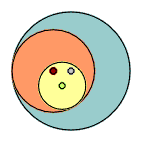
Scheme of the crop circle machine
The crescent-shaped masses can
rotate freely inside each other
I doubt it. In the near future, I'm going to do some calculations and probably a test setup. Maybe.
Have you ever heard or read from the SMOT? You should. It is said, that could be real perpetual motion machine. And where does that strange abbreviation come from?
|
|
The SMOT operates on a simple principle. The magnets accellerate a steel ball which is pulled upwards on the ramp. At the upper end of the ramp, the steel ball has enough speed to escape the magnetic field. As the ball has been lifted and accellerated, it won both potential and kinetic energy. Obviously, this is overunity behaviour.
The history is this. In 1997 Greg Wilson invented a modern variant of Taisner's idea to let a steel ball ascend a ramp by magnetic power. The SMOT idea is not new at all, as Prachar described this setup in 1922. The setup needs fine adjustment for successful operation. The unexpected takes place, the device works. My link list contains some references to sites which give detailled descriptions.
Like all ideas to build a perpetual motion machine, this is opposed by physical principles; in this case by the magnetic field theory. And so, a certain E.S. Gullible (a "colleague" of Prof. Gerhard W.Bruhn at the technical university Darmstadt) wrote an article entitled Ein Vorschlag zur radikalen Vereinfachung des SMOT. (i.e. A suggestion for radical simplification of the SMOT).
| ...next chapter |
| Last update: 22 May 2004 / |
|